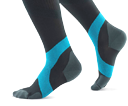| How Do Compression Stockings Work?7 October 2015 How do they work? Very well! Compression Stockings can work wonders for your legs, which is why we’ve filled our store with these great garments, so everyone can benefit! So, what exactly is it that makes these simple stockings see your circulation kept in check? Feel the SqueezeYou’ve probably felt something like compression therapy without quite knowing it. A support bandage on a sprained ankle, a tightly wound bandage on an aching arm, a rubber band worn too tight on your wrist! You were probably much more aware of your pulse because you were having a direct affect on your circulation, albeit – in the case of the rubber band – not in a good way. Compression stockings are all good, they apply a gentle and safe amount of pressure that keeps blood flow at a healthy rate. Squeezing the limb stops blood vessels expanding, so blood is kept at a controlled and healthy pace. This in turn decreases blood pressure, stops the blood from pumping in the wrong direction (remember, circulation in your legs is working against gravity) and keeps legs from feeling tired or sore throughout the long working day. Ever get swollen ankles after spending too much time on your feet? A good pair of compression stockings would keep legs feeling swell, not looking swollen. The benefits of compression stockings aren’t all about blood though, they also help keep the muscles of your legs healthy, reducing inflammation, encouraging recovery for aching and sore legs and improving overall movement that can help your legs keep going. Not Your Regular StockingNormal fashion stockings are a tight fit, but compression stockings will use stronger elastics to provide a pressure you can really feel working. So, unlike regular tights that might just look a bit bad with a bad fit, compression stocking and tights need to be sized correctly so your compression is performing just right. Different levels of mercury are also used to control compression strength, the more severe the condition, the higher the amount, with the lower figures being a great compression option for anyone, no matter your age, health or lifestyle.
Want to feel the benefits of compression? Then visit our online store and pick out your perfect pair! |







